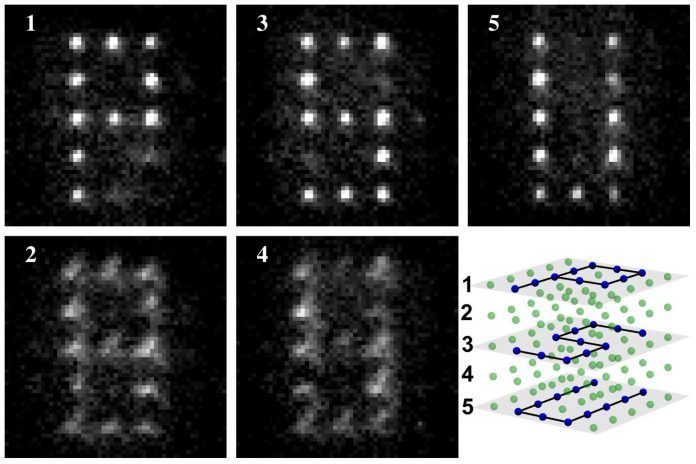The research team from Penn State University develop a new technique to pack large quantum computing power into a much smaller space. This new technique comes with much greater control than ever before. David S. Weiss, professor of physics at Penn State University, and three students on his lab team made this research advance. They used a 3-dimensional array of atoms in quantum states called quantum bits or qubits.
He said, “Our result is one of the many important developments that still are needed on the way to achieving quantum computers that will be useful for doing computations that are impossible to do today, with applications in cryptography for electronic data security and other computing-intensive fields.”
Laser light and microwaves are used by this new technique. Both maintain switching of picked individual qubits from one quantum state to another. This process is done without changing the states of the other atoms in the cubic array. Thus, this new technique shows that the potential use of atoms as the building blocks of circuits in future quantum computers.
First, the scientists innovate a creative way to set control the qubits exactly This was essential for doing calculations in a quantum computer. This research proves that this new approach is an exact, accurate, and effective way to maintain a large collection of qubits for quantum computing. The achievement of this technique is expected to be useful to scientists pursuing other approaches to building a quantum computer, including those based on other atoms, on ions, or on atom-like systems in 1 or 2 dimensions.
Weiss claimed, “If this technique is adopted in those other geometries, they would also get this robustness.”
The team developed a lattice, to ensure their quantum atoms into an orderly 3-D pattern for their experiments.This lattice was made up of beams of light to hook and hold the atoms in a cubic arrangement of five stacked planes. They were like a sandwich made with five slices of bread, where each with room for 25 equally spaced atoms. The arrangement develops a cube with the sequential design of individual locations for 125 atoms. Then, the scientists filled some of the possible locations with qubits. These qubits are consists of a neutral cesium atom those without a positive or a negative charge. Each of the qubits in the Weiss team’s experiment has the difficult-to-imagine ability to be in more than one state at the same time. There is a central feature of quantum mechanics called quantum superposition.
After that, Weiss and his team then use another kind of light tool. This light tool crossed beams of laser light for targeting different atoms in the lattice. The focus of these two laser beams, called “addressing” beams, on a targeted atom. It passes some of that atom’s energy levels by doubling as much as it does for those of any of the other atoms in the array. including those that were in the path of one of the addressing beams on its way to the target. When the scientists then bathe the whole array with a uniform wash of microwaves, the state of the atom with the shifted energy levels is changed, while the states of all the other atoms are not. The path of one of the addressing beams on its way to the target are also involved in it. When the scientists then washed the whole array with a uniform wash of microwaves.Thus, the state of the atom with the shifted energy levels is changed, while the states of all the other atoms are no.
Weiss said, “We have set more qubits into different, precise quantum superpositions at the same time than in any previous experimental system.”
The scientists also designed their system to be very insensitive. It is for the exact details of the alignments or the power of those light beams they using. This is a good thing because you don’t want to depend on exactly what the intensity of the light is or exactly what the alignment is.”
Scientists just replaced the selected atoms state in three stacked planes for changing the quantum state of individual atoms. Those stacked planes were within the cubic array to draw the letters P, S, and U. These letters represent Penn State University.
Weiss said, “We have a pretty high-fidelity system. We can do targeted selections with a reliability of about 99.7%, and we have a plan for making that more like 99.99%. I hope, constructing on the techniques demonstrated in his team’s prototype system e will enable his lab to demonstrate high-quality entangling operations for quantum computing. Filling the cube with exactly one atom per site and setting up entanglements between atoms at any of the sites that we choose are among our nearer-term research goals.”
Recommended for you
- Neuromorphic Computing Mimics Important Brain Feature
- New Form of Cloud Computing System: Wearable Cloud
- Parallel programming made easy
